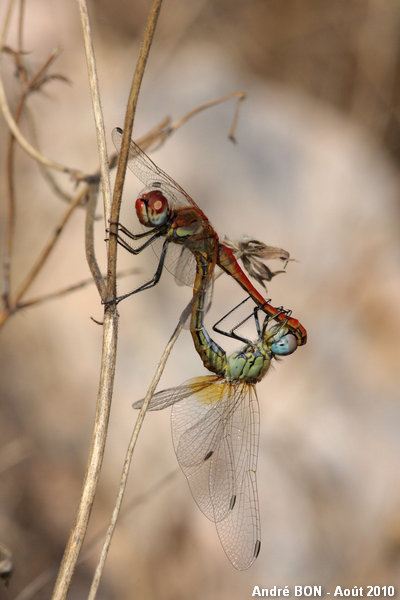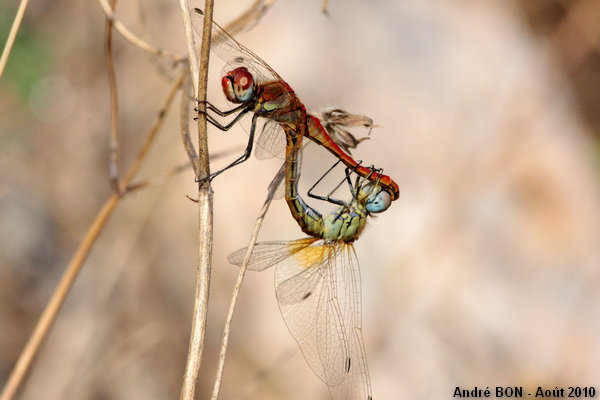

| Red-veined Darter (Sympetrum fonscolombii (Selys, 1840)) |


|
|
Scientific name: Sympetrum fonscolombii (Selys, 1840) Common name: Red-veined Darter French name: Sympétrum à nervures rouges, Sympétrum de Fonscolombe. Order: Odonata Suborder: Anisoptera Family: Libellulidae Wingspan: 62 mm. Biotope: Temperate and shallow stagnant water with sparse or missing vegetation. Geographic area: Southern Europe including the Mediterranean islands, Middle-East, Africa, south-eastern Asia. Some years you can observe migrations northwards, observations were done in Sweden or in Finland as an example. Flight time: May to October. All year long around the Mediterranean sea. |
Mature male Red-veined Darters are a bright red colour. The front of the head is red, the sides are pale. The sides of the thorax are dark with an oblique pale stripe. Female and immature Red-veined Darters are yellowish. One of the most typical characteristic is the grey blue colour of the lower part of the eyes. The main veins on the base and on the costal edge of the wings are yellowish and turn to red on mature males. The base of the hind wings shows a yellow colour which never extends over the whole width of the wings like on the Yellow-winged Darter (Sympetrum flaveolum). The legs are black with yellow longitudinal lines. This differentiates the Red-veined Darter from the Ruddy Darter (Sympetrum sanguineum). The Red-veined Darter has pale pterostigmas bordered with black lines, they are darker on the Ruddy Darter. The upper side of abdominal segments 7 and 8 bear clearly visible black marks which are missing on the Southern Darter (Sympetrum meridionale). The reproduction cycle is rather fast and there are several generations per year. This is often one of the first sympetrum species which emerges in spring, as early as May. |
| [To know more about the Red-veined Darter] [Next picture] [Top] |

|
This is my wife who noticed this mating while we were visiting the site of the "barrage du Malpasset". You can see many of the characteristics of the Red-veined Darter on this picture, and furthermore you have male and female on the same picture. |
| [To know more about the Red-veined Darter] [Previous picture] [Top] |

|
The Red-veined Darter is the dragonfly that I have most often seen during this summer stay in the south of France. |